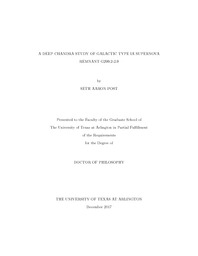
ATTENTION: The works hosted here are being migrated to a new repository that will consolidate resources, improve discoverability, and better show UTA's research impact on the global community. We will update authors as the migration progresses. Please see MavMatrix for more information.
Show simple item record
| dc.contributor.advisor | Park, Sangwook | |
| dc.creator | Post, Seth Aaron | |
| dc.date.accessioned | 2018-02-15T20:09:25Z | |
| dc.date.available | 2018-02-15T20:09:25Z | |
| dc.date.created | 2017-12 | |
| dc.date.issued | 2017-12-07 | |
| dc.date.submitted | December 2017 | |
| dc.identifier.uri | http://hdl.handle.net/10106/27165 | |
| dc.description.abstract | In this thesis we perform a comprehensive analysis of Galactic Type Ia supernova remnant G299.2-2.9. For this study we analyze our deep 628 ks Chandra observation data of G299.2-2.9. G299.2-2.9 has a complex multiple shell-like structure consisting of a bright inner shell, with enhancements ("knots") in the northeastern portion of the shell, and a fainter diffuse outer shell. Our spectral analysis of the outer shells of G299.2-2.9 shows that the bright inner and faint outer shells appear to be emission features from the swept-up ambient medium (by the supernova blast wave) whose density is relatively uniform along the distance from the center of the remnant. We find a density gradient of a factor of ~3 between the bright inner and faint outer shells. Our analysis of the shell regions suggests that the multiple shell morphology is likely the result of an explosion taking place on the boundary of two regions of interstellar material with differing densities. Based on our equivalent width images and elemental abundance measurements from our spectral analysis throughout the entire remnant we reveal a highly asymmetrical spatial distribution of metal-rich ejecta gas. The metal-rich ejecta gas is present mainly throughout the central regions (surrounded by the outer shells of swept-up ambient medium). In particular we find an intriguing continuous extension of Fe- and Si-rich gas in the western direction. This asymmetric distribution of metal-rich ejecta gas is likely caused by an asymmetric explosion of the progenitor, but non-uniform expansion of the ejecta within the two regions of interstellar material with differing densities cannot be ruled out. We place a new conservative upper limit (8 kpc) on the distance to G299.2-2.9 based on our analysis of HI gas distribution along the line of sight. Based on our new distance upper limit, we place a tight constraint on the distance, d ~ 5 kpc (with ~50% errors) to G299.2-2.9, and then we estimate an explosion energy E_0 ~ 1.8 x 10^51 erg. We estimate a total Fe mass M_Fe ~ 0.17 M_Sun and a total ejecta mass of M_ej ~ 0.50 M_Sun for G299.2-2.9.These estimated values are significantly below those of a canonical Type Ia supernova. Based on these results we propose that G299.2-2.9 may be the result of a double detonation of a sub-Chandrasekhar mass white dwarf or the failed deflagration of a white dwarf. | |
| dc.format.mimetype | application/pdf | |
| dc.language.iso | en_US | |
| dc.subject | Supernova remnant | |
| dc.subject | X-ray | |
| dc.subject | Astronomy | |
| dc.title | A Deep Chandra Study of Galactic Type Ia Supernova Remnant G299.2-2.9 | |
| dc.type | Thesis | |
| dc.degree.department | Physics | |
| dc.degree.name | Doctor of Philosophy in Physics and Applied Physics | |
| dc.date.updated | 2018-02-15T20:11:32Z | |
| thesis.degree.department | Physics | |
| thesis.degree.grantor | The University of Texas at Arlington | |
| thesis.degree.level | Doctoral | |
| thesis.degree.name | Doctor of Philosophy in Physics and Applied Physics | |
| dc.type.material | text | |
| dc.creator.orcid | 0000-0001-5326-8498 | |
Files in this item
- Name:
- POST-DISSERTATION-2017.pdf
- Size:
- 2.548Mb
- Format:
- PDF
This item appears in the following Collection(s)
Show simple item record


